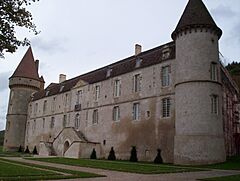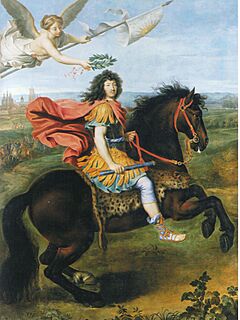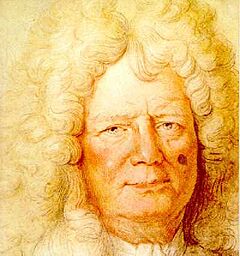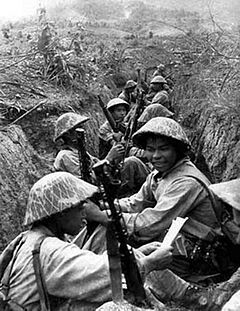Sébastien Le Prestre, Marquis of Vauban facts for kids
Quick facts for kids
Marshal
Sébastien Le Prestre
|
|
|---|---|
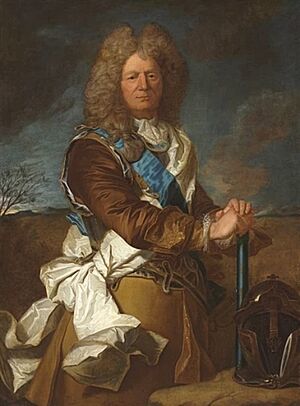
Maréchal Vauban, by Hyacinthe Rigaud, 17th century
|
|
| Born | 15 May 1633 Saint-Léger-de-Fourcheret, Burgundy, Kingdom of France |
| Died | 30 March 1707 (aged 73) Paris, Kingdom of France |
| Buried |
Bazoches, later reburied in Les Invalides
|
| Allegiance | |
| Service/ |
|
| Years of service | 1651–1703 |
| Rank | Maréchal de France, 1703 |
| Commands held | Commissaire général des fortifications (Commissioner General of Fortifications) (1678–1703) |
| Battles/wars | |
| Awards |
|
| Signature | |
Sébastien Le Prestre, Marquis de Vauban (born May 15, 1633 – died March 30, 1707), often called Vauban, was a famous French military engineer. He worked for Louis XIV, the King of France. Many people think he was the best engineer of his time. He is also considered one of the most important in European military history.
Vauban's ideas for building strong forts were used for almost 100 years. His attack plans were even used until the mid-1900s. He believed that regular roads and canals were important for the army. He helped build many of France's main ports. He also worked on projects like the Canal de la Bruche, which is still used today. He started the Royal Corps of Military Engineers. Their training was based on his writings about engineering and strategy.
He wrote a book called La Dîme royale about economics. It used facts and numbers to support his ideas. This made it an early example of modern economics. The king later ordered it destroyed. It suggested a fairer way to collect taxes. Vauban used scientific ways to solve problems. This was a new way of thinking, like what happened later in the Age of Enlightenment.
Vauban also had a lasting idea about France's shape. He thought France should give up some land for better borders. This was unusual back then. The borders he suggested in the north and east of France are still very similar today.
Contents
Early Life and Education
Sébastien le Prestre de Vauban was born in May 1633. His birthplace was Saint-Léger-de-Foucheret, in France. Today, this town is called Saint-Léger-Vauban. His parents, Urbain Le Prestre and Edmée de Cormignolle, were from a less wealthy noble family.
In 1570, Vauban's grandfather bought Château de Bazoches. But a long legal fight to keep the property cost the family a lot of money. Because of this, Vauban's father became a forestry worker. He also designed gardens for rich families nearby. Vauban spent his early years at one of these places, the Château de Ruère.
Vauban had many relatives. His cousin, Paul le Prestre, was an army officer. Paul helped build Les Invalides, a famous building in Paris. Three of Paul's sons joined the army. Antoine, one of Paul's sons, became Vauban's helper. He later became a high-ranking general. Antoine inherited Vauban's titles and most of his land.
Vauban's family was affected by wars in France. These included the Franco-Spanish War (1635–1659) and the Fronde. His family had both Catholic and Protestant members. Some of his uncles died fighting in the war with Spain.
Vauban's Military Career
In 1643, when Vauban was ten, he went to a school in Semur-en-Auxois. There, he learned math, science, and geometry. His father's work designing gardens was also helpful. Designing gardens and forts both involve planning spaces. It was common for people to have both skills.
In 1650, Vauban joined the household of Prince de Condé. He met Charles de Montal, who became a long-time colleague. During a civil war in France (the Fronde), Condé was arrested. After he was freed, Condé and his supporters, including Vauban, joined Spain.
In 1653, Vauban was working on defenses for Sainte-Menehould. He was captured by the French king's forces. He then switched sides and joined the king's army. He worked for Louis Nicolas de Clerville, a top engineer. In 1655, Vauban became a Royal Engineer. By 1659, he was known as a very skilled and brave engineer.
After the war with Spain, France gained land. Vauban was put in charge of building forts in new towns like Dunkirk. France kept gaining land and Vauban kept building forts. This happened during the War of Devolution (1667–1668) and the Franco-Dutch War (1672–1678).
Vauban designed his first fort in 1673 at the siege of Maastricht. The king was there and took credit for the victory. Vauban was given a lot of money. He used it to buy the Château de Bazouches in 1675.
After 1673, Vauban suggested a line of forts for France's northern border. This line was called the Ceinture de fer, or 'iron belt'. He became a general in 1676. In 1677, he became the chief engineer for all French forts.
During the Nine Years' War, Vauban oversaw the capture of Namur in 1692. This was a big French success. The siege of Ath in 1697 is seen as one of his best attacks. He was rewarded with money and honors. He also became an honorary member of the French Academy of Sciences.
Armies during the Nine Years' War were very large. They often had over 100,000 soldiers. This was too many for countries to support for long. So, tactics changed. In the War of the Spanish Succession, armies were smaller, about 35,000 men. Moving quickly became more important than long sieges.
In 1703, Vauban became a Marshal of France. This was the end of his military career. However, his 'iron belt' of forts proved very useful after France lost the Battle of Ramillies in 1706. Even though France was under pressure, its northern border held strong. Capturing Lille in 1708 cost the enemy many soldiers and a whole fighting season. This allowed France to get a better peace deal in 1713.
With more free time, Vauban thought about his role more broadly. His forts needed roads, bridges, and canals to connect them. Soldiers in forts needed food. So, he mapped out where to find supplies. Since these cost money, he became interested in taxes. In 1707, he published La Dîme royale. This book showed how poor the lower classes were. He suggested a flat 10% tax on all goods. He also wanted to remove tax breaks for nobles and clergy. The king ordered the book destroyed. But Vauban's use of facts to support his ideas makes him a founder of modern economics.
Vauban oversaw or designed over 300 different forts. He also managed over 40 sieges between 1653 and 1697.
Personal Life and Death

In 1660, Vauban married Jeanne d'Aunay d'Epiry. They had two daughters, Charlotte and Jeanne Françoise. They also had a son who died young. Vauban also had a long relationship with Marie-Antoinette de Puy-Montbrun.
Vauban died in Paris on March 30, 1707. He was buried near his home in Bazoches. His grave was destroyed during the French Revolution. In 1808, Napoleon I ordered his heart to be reburied in Les Invalides. This is where many of France's most famous soldiers are laid to rest.
Vauban's Military Ideas
Attacking Forts: Siege Warfare
Vauban is famous for his forts, but his biggest ideas were about attacking forts. He summed up his approach as 'More powder, less blood.' This meant using more cannons to save soldiers' lives. He wrote down his ideas in a guide for sieges in 1672.
During this time, sieges were the main type of warfare. Kings like Louis XIV saw them as a safe way to show off their military skill. Louis XIV was present at 20 of Vauban's sieges.
The idea of 'siege parallels' had been around for a while. But Vauban made it work well at Maastricht in 1673. Attackers dug three parallel trenches in front of the fort walls. The dirt from the trenches created banks to protect the attackers. This brought them very close to the fort. Cannons were moved into these trenches. This allowed them to shoot at the base of the walls from close range. Once a hole was made in the wall, soldiers would storm it. This method of attack was used for centuries.
Vauban also changed his approach based on the situation. At Valenciennes in 1677, he suggested attacking the fort during the day. Normally, attacks happened at night. He argued this would surprise the defenders and save lives. Louis XIV supported him, and the attack worked.
Vauban also improved how siege cannons were used. He introduced 'ricochet firing,' where cannonballs bounced along the ground. He also focused fire on specific parts of the fort. His Dutch rival, Menno van Coehoorn, had similar ideas. Van Coehoorn used massive firepower. Vauban preferred a slower, more careful approach. Vauban believed his method caused fewer deaths. But it took more time, which was important because disease killed more soldiers than battles.
Defending Forts: Fortifications
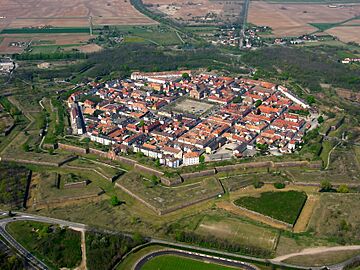
It was understood that even the strongest forts would eventually fall. Forts were designed to slow down attackers. This gave defenders time to gather more soldiers. The French defense of Namur in 1695 showed this. They lost the fort but tired out the attackers.
Vauban's defensive designs were strong because he combined and improved others' ideas. His early forts used the 'star-shape' or bastion fort design. His later designs added stronger inner parts.
Vauban's 'second system' of defense was described in a book in 1683. It was used at Landau and Mont-Royal. These were advanced forts meant for French attacks into Germany. Mont-Royal was very expensive to build. It was destroyed when the French left in 1697. Fort-Louis was another new fort. It was built on an island in the Rhine river. Vauban combined his defense ideas with town planning there.
After 1697, France needed new forts. Neuf-Brisach was the most important. It was designed using Vauban's 'third system'. It had a square street plan inside an octagonal fort. Houses were built into the outer walls. This made the walls stronger and protected the houses from cannon fire.
Vauban believed in having a strong, clear border. He suggested destroying weak forts. He also thought France should give up land that was hard to defend. In 1672, he wrote that France had too many forts. He wished they had half as many, but all in good condition.
Many of Vauban's forts are still standing today. In 2008, twelve groups of Vauban's forts were named UNESCO World Heritage Sites. This was because of their amazing engineering and influence on military forts.
Infrastructure and Engineering Projects
Vauban also worked on many projects for everyday life. He helped rebuild ports like Brest, Dunkerque, and Toulon. Since his forts supported each other, roads and waterways were key. The Canal de la Bruche is an example. It's a 20-kilometer canal built in 1682. It was used to transport materials for the fort at Strasbourg. He also gave advice on fixing and enlarging the Canal du Midi in 1686.
His ideas about city planning were very complete. He combined city defenses with the layout of the city and its services. This is clearest at Neuf-Brisach. The Vauban district in Freiburg, Germany, is a modern example. It was built as a model for sustainable neighborhoods.
Vauban's scientific approach greatly influenced American military engineering. It inspired the creation of the US Corps of Engineers in 1824. Until 1866, the US military academy West Point taught engineering and math like French schools.
In 1690, Vauban started the Royal Corps of Military Engineers. Until he died, he personally tested all candidates. Many young French Protestants became engineers. After 1685, many of these engineers joined the English and Dutch armies. Vauban wrote many books, like Traité de l'attaque des places, to train future engineers.
How Vauban is Remembered
Vauban's attack methods were useful for centuries. His ideas were still seen in the tactics used at Dien Bien Phu in 1954. However, his defensive forts became outdated more quickly. This was partly because they cost so much to build. Vauban himself estimated that in some years, almost half of the French army was guarding forts.
Vauban's fame meant his designs were used even when new cannons made them less effective. For example, the Dutch fort of Fort Bourtange was built in 1742 using his ideas. The Corps of Military Engineers followed his teachings. This made French military engineering very traditional. Many new forts still used his designs.
Some French engineers did try new things. The Marquis de Montalembert published new ideas in 1776. He rejected Vauban's principles. His ideas became popular in other parts of Europe but not in France.
See also
 In Spanish: Vauban para niños
In Spanish: Vauban para niños
- Vauban fortifications
- Fortifications of Vauban UNESCO World Heritage Sites: UNESCO World Heritage Sites preserving many of Vauban's fortifications.


